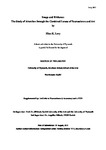Image and Evidence: The Study of Attention through the Combined Lenses of Neuroscience and Art
| dc.contributor.supervisor | Scott, Jill | |
| dc.contributor.author | Levy, Ellen K. | |
| dc.contributor.other | Faculty of Arts, Humanities and Business | en_US |
| dc.date.accessioned | 2012-02-29T11:29:54Z | |
| dc.date.available | 2012-02-29T11:29:54Z | |
| dc.date.issued | 2012 | |
| dc.identifier | 10100557 | en_US |
| dc.identifier.uri | http://hdl.handle.net/10026.1/914 | |
| dc.description | : Levy, EK 2012, ‘An artistic exploration of inattention blindness’, in Frontiers Hum Neurosci, vol. 5, ISSN=1662-5161. | en_US |
| dc.description | Full version unavailable due to 3rd party copyright restrictions. | |
| dc.description.abstract |
This study proposed that new insights about attention, including its phenomenon and pathology, would be provided by combining perspectives of the neurobiological discourse about attention with analyses of artworks that exploit the constraints of the attentional system. To advance the central argument that art offers a training ground for the attentional system, a wide range of contemporary art was analysed in light of specific tasks invoked. The kinds of cognitive tasks these works initiate with respect to the attentional system have been particularly critical to this research. Attention was explored within the context of transdisciplinary art practices, varied circumstances of viewing, new neuroscientific findings, and new approaches towards learning. Research for this dissertation required practical investigations in a gallery setting, and this original work was contextualised and correlated with pertinent neuroscientific approaches. It was also concluded that art can enhance public awareness of attention disorders and assist the public in discriminating between medical and social factors through questioning how norms of behaviour are defined and measured. This territory was examined through the comparative analysis of several diagnostic tests for attention deficit hyperactivity disorder (ADHD), through the adaptation of a methodology from economics involving patent citation in order to show market incentives, and through examples of data visualisation. The construction of an installation and collaborative animation allowed participants to experience first-hand the constraints on the attentional system, provoking awareness of our own “normal” physiological limitations. The embodied knowledge of images, emotion, and social context that are deeply embedded in art practices appeared to be capable of supplementing neuroscience’s understanding of attention and its disorders. | en_US |
| dc.language.iso | en | en_US |
| dc.publisher | University of Plymouth | en_US |
| dc.subject | Attentional system | en_US |
| dc.subject | Constraints | |
| dc.subject | Attention training | |
| dc.subject | Norms | |
| dc.title | Image and Evidence: The Study of Attention through the Combined Lenses of Neuroscience and Art | en_US |
| dc.type | Thesis | |
| dc.identifier.doi | http://dx.doi.org/10.24382/4068 |
Files in this item
This item appears in the following Collection(s)
-
01 Research Theses Main Collection
Research Theses Main


